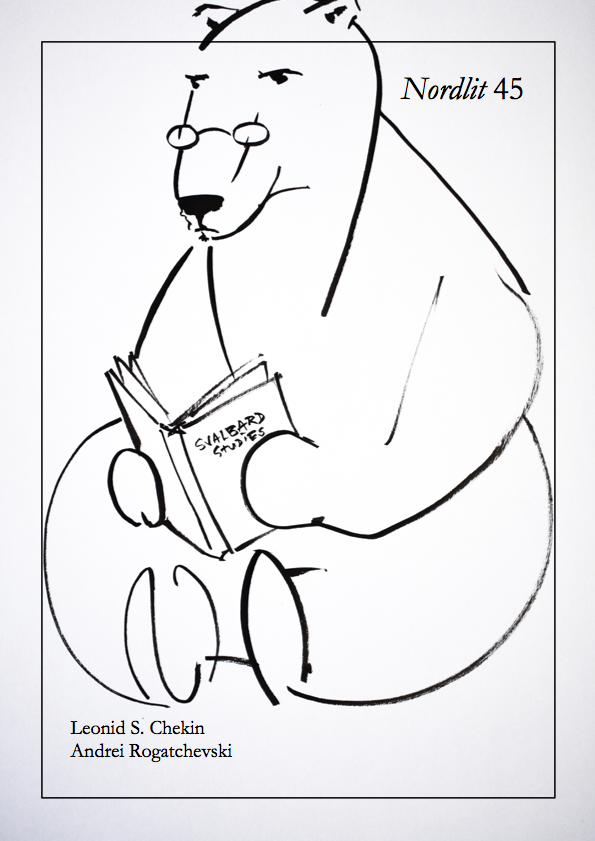Svalbard’s Haunted Landscapes
DOI:
https://doi.org/10.7557/13.5028Keywords:
Landscape, Svalbard, Arctic, haunting, ghost, heritageAbstract
Cultural landscapes represent social structures, interests, and values. At the same time, the observer can derive, interpret, reinterpret, and inscribe new meanings to the landscape. Landscapes that are saturated with ideologically charged symbols dictate to the viewer what can and cannot be seen and derived from them. On the other hand, landscapes that are abandoned, ruined, partly erased, and deprived of actors, activities, and political context present a different sort of setting. What can be derived from them? What or whom do they represent? Can the current conceptualisations help to capture their meanings? This paper attempts to expand the debate on cultural landscapes, by exploring the linkages to the concepts of haunting and ghosts. It uses the Russian settlements of Barentsburg, Pyramiden and Grumant, located in Svalbard (Norway), as an example. The paper argues that ruined and abandoned landscapes are ‘haunted’, and that the viewer can engage with a haunted landscape through interactions with ‘ghosts’ – fictitious agents that fulfil two roles: i) allowing the viewer to associate with the ghost, and ii) reminding the viewer of the bygone actors, forces, and contexts that shaped the landscape.
References
Arktikugol’. 2018. Barentsburg. Moscow: State Trust Arktikugol’, accessed 4 September 2018. http://www.arcticugol.ru/index.php/rudniki/barentsburg
Avango, Dag, Louwrens Hacquebord, Ypie Aalders, Hidde De Haas, Ulf Gustafsson and Frigga Kruse. 2011. “Between markets and geo-politics: Natural resource exploitation on Spitsbergen from 1600 to the present day”. Polar Record 47, 1: 29–39. https://doi.org/10.1017/S0032247410000069
Arlov, Thor B. 2016. Istoriya аrkhipelaga Shpitsbergen (A History of the Spitsbergen Archipelago). Moscow: Paulsen.
Ashworth, Gregory J., Brian Graham and John E. Tunbridge. 2007. Pluralising Pasts: Heritage, Identity and Place in Multicultural Societies. London: Pluto Press.
Bell, Michael. 1997. “The ghosts of place”. Theory and Society 26: 813–836. https://doi.org/10.1023/A:1006888230610
Cameron, Emilie. 2008. “Indigenous spectrality and the politics of postcolonial ghost stories”. Cultural Geographies 15 (3): 383–393. https://doi.org/10.1177/1474474008091334
Cosgrove, Denis E. 1998. Social Formation and Symbolic Landscape. Madison, WI: The University of Wisconsin Press.
Czepczyński, Mariusz. 2008. Cultural Landscapes of Post-Socialist Cities. London: Routledge.
Daniels, Stephen and Denis Cosgrove. 1988. “Introduction: iconography and landscape”, in: The Iconography of Landscape, ed. by Denis Cosgrove and Stephen Daniels, 1–10. Cambridge: Cambridge University Press.
de Brito, Alexandra Barahona. 2010. “Transitional justice and memory: Exploring perspectives”. South European Society and Politics 15: 359–376. https://doi.org/10.1080/13608746.2010.513599
Duncan, James. S. and Nancy Duncan. 1988. “(Re)reading the landscape”. Environment and Planning D: Society and Space 6 (1988), 117–126. https://doi.org/10.1068/d060117
Edensor, Tim. 2005. “The ghosts of industrial ruins: Ordering and disordering memory in excessive space”. Environment and Planning D: Society and Space 23: 829–849. https://doi.org/10.1068/d58j
Fløgstad, Kjartan. 2008. Piramida. Portret Zabroshennoy Utopii (Pyramiden: Portrett an ein Forlaten Utopi). Moscow: MIK.
Fortin, Jacey. 2017. “The Statue at the Center of Charlottesville’s Storm”. The New York Times (13 August 2017), accessed 2 September 2018. https://www.nytimes.com/2017/08/13/us/charlottesville-rally-protest-statue.html
Forest, Benjamin and Juliet Johnson. 2019. “Confederate monuments and the problem of forgetting”. Cultural Geographies in Practice 26 (1): 127–131. https://doi.org/10.1177/1474474018796653
Gerlach, Julia and Nadir Kinossian. 2016. “Cultural landscape of the Arctic: ‘Recycling’ of Soviet imagery in the Russian settlements on Svalbard (Norway)”. Polar Geography 39 (1): 1–19. https://doi.org/10.1080/1088937X.2016.1151959
Gordon, Avery. 2008. Ghostly Matters. Haunting and the Sociological Imagination (New Edition). Minneapolis: University of Minnesota Press.
Johnson, Nuala C. 2012. “The contours of memory in post-conflict societies: Enacting public remembrance of the bomb in Omagh, Northern Ireland”. Cultural Geographies 19 (2): 237–258. https://doi.org/10.1177/1474474011422026
Kinossian, Nadir. 2012. “Post-socialist transition and remaking the city: political construction of heritage in Tatarstan”. Europe-Asia Studies 64 (5): 879–901. https://doi.org/10.1080/09668136.2012.681270
Kinossian, Nadir. 2018. “Cities as haunted landscapes”, City and Society 30 (1). https://doi.org/10.1111/ciso.12151
Kinossian, Nadir and Urban Wråkberg. 2017. “Palimpsests”. in: Border Aesthetics. Concepts and Intersections, ed. by Johan Schimanski and Stephen F. Wolfe, 90–110. New York and Oxford: Berghahn Books.
Ladd, Brian. 1998. The Ghosts of Berlin. Confronting German History in the Urban Landscape. Chicago and London: The University of Chicago Press. https://doi.org/10.7208/chicago/9780226467603.001.0001
Lehti, Marko, Matti Jutila and Markku Jokisipilä. 2008. “Never-ending Second World War: Public performances of national dignity and drama of the bronze soldier”. Journal of Baltic Studies 39 (4): 393–418. https://doi.org/10.1080/01629770802461175
Lennon, John and Malcolm Foley. 2010. Dark Tourism. The Attraction of Death and Disaster. Andover: Cengate Learning.
Light, Duncan and Craig Young. 2013. “Urban space, political identity and the unwanted legacies of state socialism: Bucharest's problematic Centru Civic in the post-socialist era”. Nationalities Papers: The Journal of Nationalism and Ethnicity 41: 515–535. https://doi.org/10.1080/00905992.2012.743512
Light, Duncan and Craig Young. 2014. “Habit, memory, and the persistence of Socialist-era street names in postsocialist Bucharest, Romania”. Annals of the Association of American Geographers 104 (3): 668–685. https://doi.org/10.1080/00045608.2014.892377
Light, Duncan and Craig Young. 2015. “Public memory, commemoration and transitional justice: Reconfiguring the past in public space”. in: Post-Communist Transitional Justice: Lessons from Twenty-Five Years of Experience, ed. by Lavinia Stan and Nadya Nedelsky, 233–251. New York: Cambridge University Press. https://doi.org/10.1017/CBO9781107588516.017
Mitchell, Don. 2000. Cultural Geography. A Critical Introduction. Oxford: Blackwell Publishers Ltd.
Mitchell, Don. 2003. “Dead Labor and the Political Economy of Landscape — California Living, California Dying”, in: Handbook of Cultural Geography, ed. by Kay Anderson, Mona Domosh, Steve Pile, and Nigel Thrift, 233–248. London: Sage. https://doi.org/10.4135/9781848608252.n16
Radway, Janice. 2008. “Foreword”. in: Ghostly Matters. Haunting and the Sociological Imagination (New Edition), ed. by Avery Gordon. Minneapolis: University of Minnesota Press.
Smith, Laurajane. 2006. Uses of Heritage. Abingdon: Routledge. https://doi.org/10.4324/9780203602263
Till, Karen. 2005. The New Berlin. Memory, Politics, Place. Minneapolis and London: University of Minnesota Press.
Viken, Arvid. 2011. “Tourism, research, and governance on Svalbard: A symbiotic relationship”. Polar Record 47 (4): 335–347. http://doi.org/10.1017/S0032247410000604
Wylie, John. 2007. Landscape (Key Ideas in Geography). London and New York: Routledge.
Zerubavel, Eviatar. 2003. Time Maps. Collective Memory and the Social Shape of the Past. Chicago: University of Chicago Press. https://doi.org/10.7208/chicago/9780226924908.001.0001
Zinger, Evgeniy. 2014. Put’ na Shpitsbergen (The Road to Spitsbergen). Moscow: Arktikugol’.









